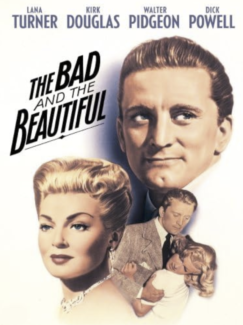The Bad and The Beautiful (Vincente Minnelli, 1952): U.S.A.
Reviewed by Larry Gleeson during TCM’s 31 Days of Oscar
 The Bad and the Beautiful (1952), directed by Vincente Minelli and music by David Raskin, tells the story of an ambitious producer, Jonathan Shields, portrayed by Kirk Douglas. Minelli utilizes flashbacks with voice over narration from the individuals who had worked with Shields; writer James Lee Bartlow, portrayed by Dick Powell, a star Georgia Lorrison, portrayed by Hollywood starlet, Lana Turner, and a director Fred Amiel, portrayed by Barry Sullivan.
The Bad and the Beautiful (1952), directed by Vincente Minelli and music by David Raskin, tells the story of an ambitious producer, Jonathan Shields, portrayed by Kirk Douglas. Minelli utilizes flashbacks with voice over narration from the individuals who had worked with Shields; writer James Lee Bartlow, portrayed by Dick Powell, a star Georgia Lorrison, portrayed by Hollywood starlet, Lana Turner, and a director Fred Amiel, portrayed by Barry Sullivan.
Interestingly, The Bad and The Beautiful seems to loosely imitate Akira Kurasowa’s Rashomon, winner of the 1951 Golden Lion, the top prize at the oldest and one of the most prestigious film festivals in the world. The film world was awestruck at the time by Kurasowa’s work and style. Furthermore, the use of the voice-over-narration, especially in the first act of The Bad and The Beautiful, Minelli employs the technique in a fashion closely resembling Billy Wilder’s use in Double Indemnity.
While The Bad and The Beautiful is typically regarded as a drama, I argue it is on the cusp of being a melodrama with the stereotypical characters, exaggerated emotions, and simplistic plot. Raskin’s musical score is impressive, and it supports the musical styles in melodramas such as Douglas Sirk’s All That Heaven Allows. What sets The Bad and The Beautiful apart is its cinematography by Robert Surtees, A.S.C., a three-time Oscar winner for Best Cinematography [King Solomon’s Mines (1951), The Bad and The Beautiful (1952), Ben Hur, 1960)]. Nevertheless, even the New York Times film critic, Bosley Crowther provides a melodramatic opening to his review:
The widely circulated notion that there are monsters in Hollywood, aside and apart entirely from the grim and ghoulish get of Frankenstein, is given unqualified endorsement, with no reservations and no holds barred, in Metro’s “The Bad and the Beautiful,”…
Back to the film. After the beginning credits roll with Lana Turner and Kirk Douglas receive top billing – in that order, the film transitions to black and a diegetic ringing is heard. The opening frame is of a solitary black rotary phone, the camera slowly pulls out as a man in a gray suit moves towards the phone and answers it. Meanwhile, the camera continues to pull out to a high angle “god shot” revealing a row of light stands spread out across the top of a large shelving apparatus above the phone.
The man answers the phone with, “Stage Five…Mr. Amiel’s on a camera boom rehearsing right now.” The film cuts to a moving elevated lift (boom) mounted with a camera, and Mr. providing direction. Also, an entire crew comes into frame as the boom moves in for a close up of a blonde-haired woman in a vertical position. Amiel directs the woman to move her hand up around her throat. The gray-suited man comes into frame with the phone announcing, “transatlantic, Paris, Jonathan Shield calling you. the camera moves into a tight-medium frame shot revealing a studio camera and Mr. Amiel operating it. Amiel doesn’t take the call and instead calls out direction for the next shot.
In my opinion, this is the film’s overwhelming strength. Minelli provides the viewer with an inside look at how films were made in the 1950’s and the people who are involved in the filmmaking process – everything from stories to scripts, producing, financing, make up, costuming, directing, and effectively handling the sensitivities of Hollywood stars of the era. The film is shot in black and white which helps with the idea of moral business ethics – one of the underlying themes of The Bad and the Beautiful. Stylistically, the film is very easy on the eyes with terrific lighting and interesting mise-en-scen. Very warmly recommended, unless you’re a Lana Turner fan, then it’s highly recommended!
About this entry
You’re currently reading “The Bad and The Beautiful (Vincente Minnelli, 1952): U.S.A.,” an entry on Student Film Reviews
- Published:
- 02.06.25 / 12pm
- Category:
- Films
No comments
Jump to comment form | comments rss [?]